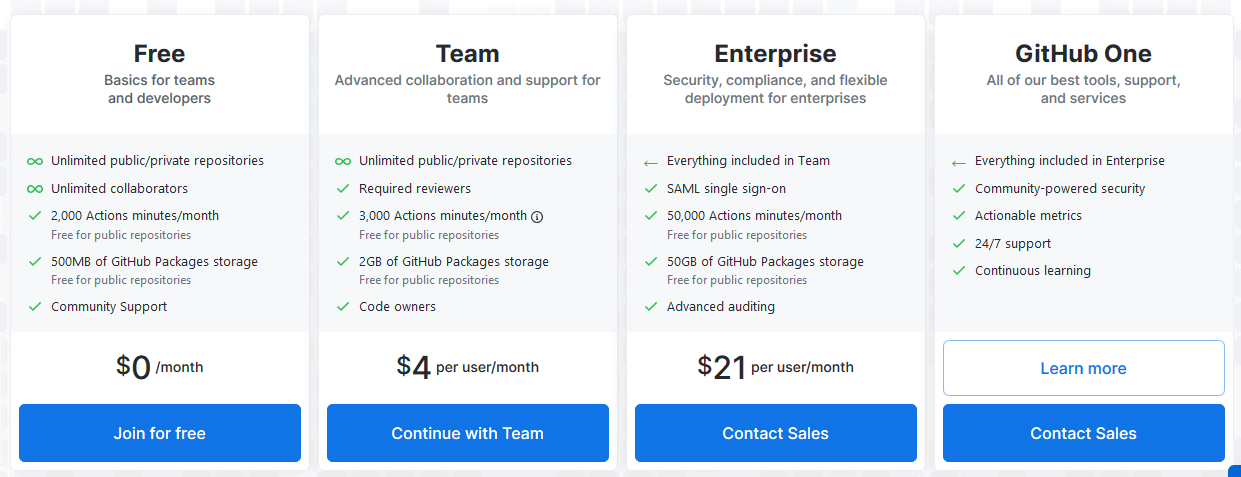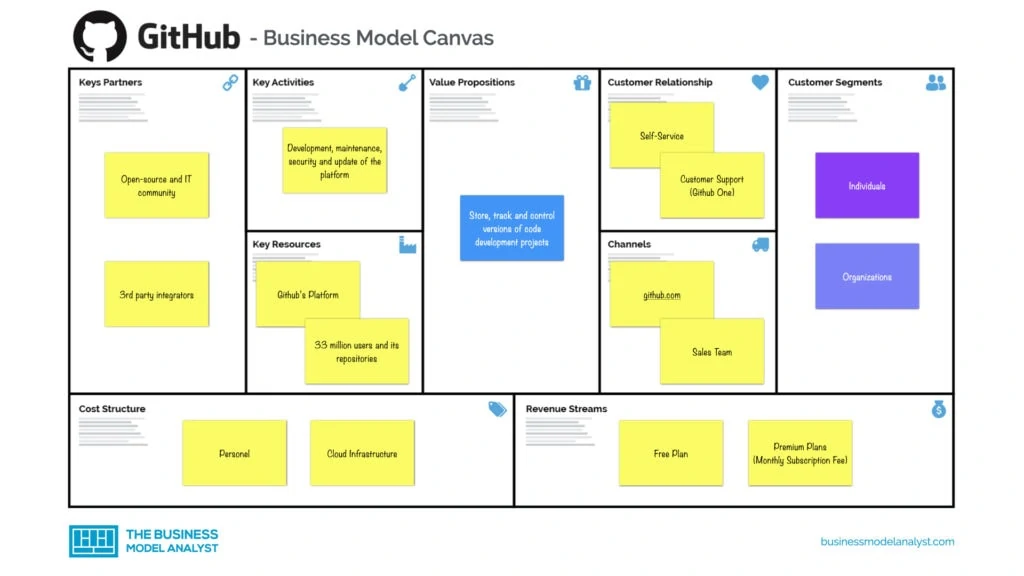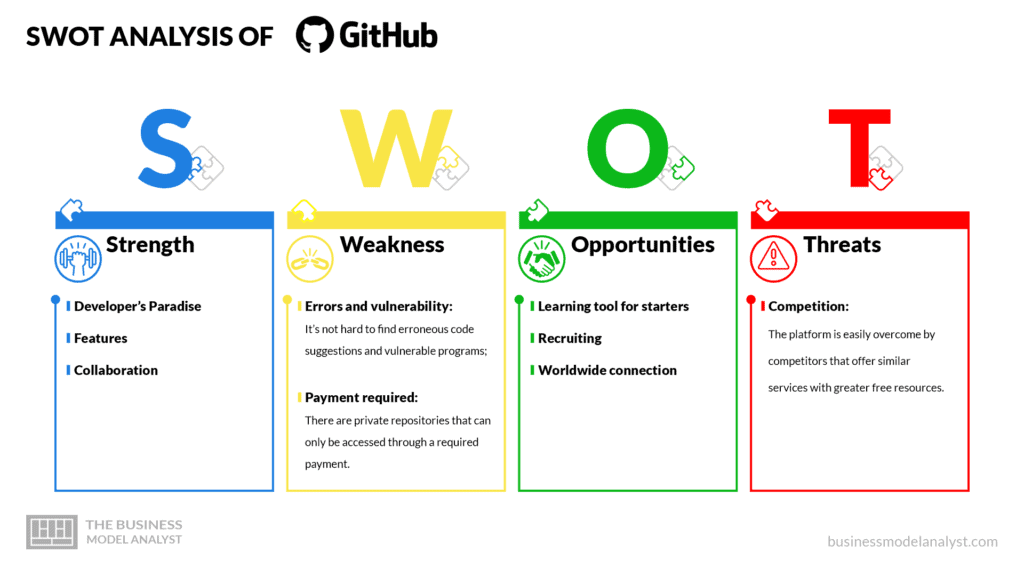The GitHub Business Model mixes both Freemium and Software-as-a-Service business models, meaning that it offers a software license in a cloud infrastructure and charges its users a monthly subscription. First things first: if you are not a developer — and have no contact with the coding world —, you may not be familiar with the name GitHub. Nevertheless, GitHub Business Model has inserted its brand among the 100 most visited websites on Earth.
Known as Google Drive for code and social networking site for programmers, this Git repository hosting service has more than 33 million unique users each month. GitHub is simply the largest software development platform in the world. It’s used both by individuals and famous big companies, in order to develop and share code. Let’s get into the GitHub business model a little deeper — from the first base.
Contents
A brief history of GitHub
GitHub was founded in 2008, by Tom Preston-Werner, Chris Wanstrath, and P. J. Hyett — all of them, software developers —, in San Francisco, California.
Preston-Werner dropped out of his Computer Science studies at Harvey Mudd College, to become a Java developer in the early 2000s. In 2003, unemployed, he decided to start Gravatar, a platform that allowed WordPress users to create and share unique avatars on websites. Four years later, Gravatar was sold for an undisclosed sum to Automattic. Soon after, he moved to San Francisco to join Powerset, a natural language search engine.
He had gotten to know Wanstrath and Hyett during one of the Ruby on Rails meetups that they attended. But, in 2008, while Preston-Werner was hanging out at a local sports bar in San Francisco, he saw Wanstrath and showed him the project he had been working on, a portal that let web developers share and edit each other’s code.
Hyett and Wanstrath both had worked at CNet together, and the trio started developing GitHub. In April 2008, the platform was launched to the public. Three months later, Powerset, Preston-Werner’s employer, was acquired by Microsoft, offering him $300,000 as a signing bonus.
However, as GitHub looked promising from the beginning, (on the launch day, it generated over $1,000 in revenue), he declined the offer. The platform spread quickly. Within its first 6 months, it had already recorded over 10,000 open source projects on its website.
In 2012, they received their first outside investment, $100 million from Andreessen Horowitz. The funding allowed GitHub to hire the necessary talents to engage in the usual sales cycles when dealing with corporates.
In March 2014, there was a complaint stating that a former employee had experienced discriminating and sexist behavior. Reports pointed out Preston-Werner and his wife as accountable for that. While they never admitted it, both resigned from the company weeks later.
In 2017, GitHub would announce its second major funding round, of $250 million, and, in 2018, 10 years after its inception, the company was acquired by Microsoft for $7.5 billion in stock. GitHub’s acquisition represented a major strategic shift that Microsoft had undergone e
Currently, more than 50 million people use GitHub’s platform. The company employs over 2,000 people across 8 worldwide offices.
What is GitHub?
GitHub is a cloud-based platform, used by developers to organize programming projects, by storing, managing, and sharing code, as well as by tracking and controlling changes to their code — all while communicating with each other. But to understand how GitHub’s business model and website work, it’s essential to get to know “Git”.
What is Git?
Git is an open-source version control system. When developers start a new project, they make recurring changes to the product code. For that, they release new versions of the code after the first official one (non-beta). Version control systems store all the modifications made in the code in a central repository, permitting these revisions to be shared, downloaded, changed, etc., providing collaboration among programmers. Created by Linus Torvalds (Linux’s creator) in 2005, Git is the most used version control system, chosen by almost 90% of developers around the world.
How GitHub works
GitHub is a company that provides a Git repository hosting service. Each project is stored in its own repository, accessed through a unique URL. It allows individuals and teams to collaborate and control code versions. Anyone can host a public code repository for free (private repositories are charged). So, if a developer finds a project that they might contribute to, they can make the changes to the original code and release a revised new project.
The programmer who revises and changes some code may even ask to be included in the official project if the original repository’s authors accept that. One of the nicest resources about GitHub is the social networking feature. Every user has a profile, that stands for a resume, with past projects and contributions. Also, the revisions can be publicly discussed, which fosters collaboration and programming advancement.
GitHub for non-programmers
GitHub’s business model has been developed for developers, surely. But that doesn’t stop other people to use it as a repository for any type of files. It’s a lot less common, but any team that needs to constantly change some file or document may take advantage of GitHub’s structure, to control versions.
Who Owns GitHub
GitHub is owned by Microsoft. The tech giant has acquired GitHub in June 2018, paying the amount of $7.5 billion. The company’s current CEO is Thomas Dohmke since November 2021, who replaced Nat Friedman, GitHub’s current Chairman.
GitHub’s Mission Statement
“To build a global platform for developer collaboration. But that platform needs to be one that all of us can use to secure the world’s software, together”.
How GitHub makes money
As mentioned above, while public code repositories are free, the private ones are paid. GitHub sells subscription plans, both to individuals and businesses. The prices vary mainly according to the number of private repositories — collaborators and public repositories are unlimited. Here are the GitHub plans:

The biggest revenue stream of Git Hub is the Enterprise plan — over 50% of its income. GitHub One aims at large companies. It has every feature from the Enterprise plan, with some extras, such as 24/7 support and community-powered security. Besides the subscription business model, GitHub also makes money from its marketplace and shop. The marketplace allows users to share their apps on the platform. On every sale made there, GitHub cuts 25% as a commission. And the GitHub Shop offers merchandise like clothes and collectibles.
GitHub’s Business Model Canvas

Let’s take a detailed look at the GitHub business model, by analyzing its Business Model Canvas‘ blocks:
GitHub’s Customer Segments
The GitHub business model’s customer segments are based on a market niche: specialized individuals and/or organizations that want a repository to host their Git code.
- Individuals will benefit from Free or Team plans, by which they can work on projects alone or in private groups;
- Organizations will benefit from an Enterprise plan, by which they can manage codes and teams on their own servers or cloud, with more space and security controls.
GitHub’s Value Propositions
The main value proposition is precisely the possibility to store, track and control projects developed on the most used version control system in the world (Git), along with the option to integrate them with other tools, and, yet, to choose to keep the code private or public. Besides that, GitHub’s reputation as the largest code host on Earth attracts a great number of programmers interested in sharing, collaborating, and being part of important coding projects.
GitHub’s Channels
GitHub’s main channel is, surely, its website. Moreover, the company offers free training coding courses, available in in-person and live web-based classes.
GitHub’s Customer Relationships
GitHub’s customer relationship is pretty reduced. The website is a user-friendly automated serf service, with limited interaction with employees. Customer support is mostly done through its Help section, FAQ and via e-mail assistance, but the most advanced plan (GitHub One) includes 24/7 support.
GitHub’s Revenue Streams
GitHub is a freemium and SaaS business model. It offers free unlimited public repositories and charges for private repositories and some advanced & customized resources on a monthly basis.
GitHub’s Key Resources
Its key resources involve GitHub’s platform, cloud systems, its 33 million users and their repositories, engineers, and staff who maintain the company and the instructors who give the training courses.
GitHub’s Key Activities
GitHub’s key activities are primarily development, maintenance, security, and update of the software platform.
GitHub’s Key Partners
Its key partners include:
- Open-source community
- Developers
- Investors
- IT community
- GitHub Student Developer Pack (12 companies that give students free access to developer tools)
GitHub’s Cost Structure
The GitHub business model aims for a lean cost structure, in order to maintain its low-price offers. Therefore, the company reduces operational expenses through a very automated system. Its costs involve personnel, customer support, and fixed general & administrative expenses.
GitHub’s Competitors
- GitLab: Founded in 2011, in San Francisco too, it is open-source software that can be downloaded and installed on your own server. It provides hosted service, and it is not very cheap;
- BitBucket: It is the repository hosting service from Atlassian, and, as it is tightly integrated with other Atlassian project management tools, it can be the favorite choice for big enterprises;
- SourceForge: A very popular among open source projects, including some Linux’s. It provides tools to import GitHub repositories;
- Google Cloud Source Repositories: With a brand that dismisses introductions, it offers a 12-month trial period and users won’t be charged unless they overcome free tier usage limits;
- AWS CodeCommit: Just like Google’s Repositories, this Amazon option provides a free tier, free forever if the user does not exceed the limits;
- Phabricator: It is an all-in-one tool that allows host coding and discussing to keep working on a project without needing to utilize separate applications for communication/collaboration;
- Gogs: It is completely self-hosted and a very lightweight alternative;
- Gitea: Another completely self-hosted and very lightweight alternative.
GitHub’s SWOT Analysis
Below, there is a detailed swot analysis of Github:

GitHub’s Strengths
- Developer’s Paradise: There’s an enormous variety in applications and interactions, among many categories;
- Features: Although there are some paid properties, it’s easy to share files, manage projects, do a quick search for what the user is looking for, and get help, when needed;
- Collaboration: GitHub provides easy and interactive collaborative projects between developers.
GitHub’s Weaknesses
- Errors and vulnerability: It’s not hard to find erroneous code suggestions and vulnerable programs;
- Payment required: There are private repositories that can only be accessed through a required payment.
GitHub’s Opportunities
- Learning tool for starters: It’s a fantastic tool for beginners to learn from way more experienced programmers;
- Recruiting: It’s a great place for Resource Human professionals to look for programmers to recruit;
- Worldwide connection: The platform provides connections between students and programmers from all around the world.
GitHub’s Threats
- Competition: The platform is easily overcome by competitors that offer similar services with greater free resources.
Conclusion
The GitHub business model has provided the world with an open-source platform, where developers from all over the world can showcase their talents and take part in large projects, by developing and sharing code effortlessly. It’s worth saying that great brands, such as Google, Facebook, Twitter, and Microsoft have projects housed on GitHub. By the way, Microsoft has seen so much value in the venture, that the giant acquired the code-repository service for the humble amount of $7.5 billion, in 2018.

